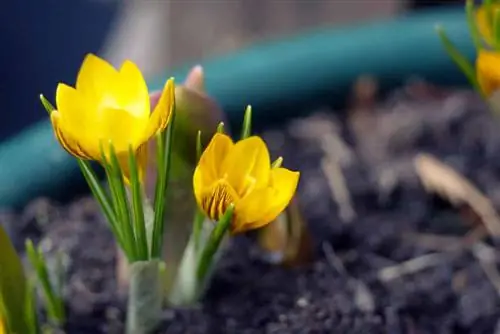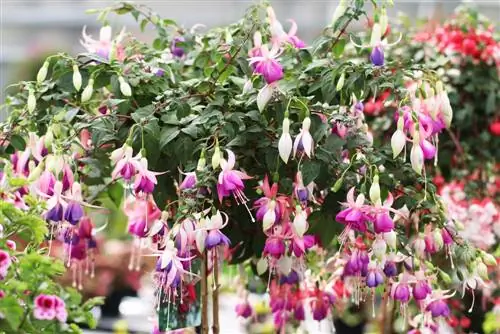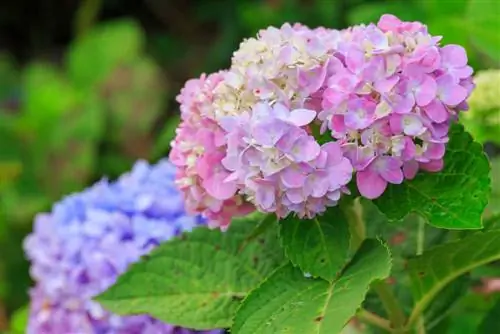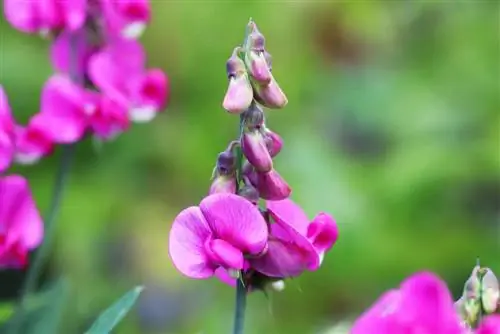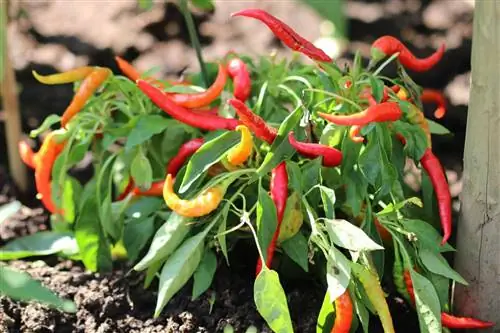- Author admin [email protected].
- Public 2023-12-17 03:39.
- Last modified 2025-01-24 12:45.
Perennials are perennial plants whose stems do not become woody. The expert speaks of herbaceous plants. Perennials sprout in spring, bloom from early summer to autumn, depending on the variety, and retreat to their underground parts in winter. The above-ground part dies off. The plants need a sufficient supply of nutrients to gather strength for the winter.
Types of perennials in German gardens
In addition to native perennials, German gardens contain many plants from the Mediterranean region and even from Africa, Asia and America. Overwintering is therefore not uniform among perennials. Some varieties do not require protection, others need to be dug up. Hollyhocks and delphiniums are hardy native perennials and do not require protection from frost. The tubers of the dahlia, which comes from Mexico, must be dug up and stored frost-free. There are several thousand varieties of perennials that vary considerably in size, appearance, flowering and winter hardiness. The small lily of the valley is a perennial, as is the giant knotweed, which can easily grow to 4 m. Poppies, irises, spring daisies and bluebells are also perennials. Despite all the diversity, there are many similarities when it comes to care.
Putting the plants in the garden
All perennials are usually only planted after frost. Most varieties are offered in pots with root balls, others as tubers. To make it easier for the plants to get started, water the tubers or root balls before planting. Mix compost into the soil at the planting site to make it loose and permeable. In addition, you ensure an adequate supply of nutrients to the rapidly growing perennials. The optimal planting depth varies depending on the variety. For potted products, the top edge of the soil in the pot should be flush with the garden soil after digging. Support is needed for tall growing varieties, especially since cultivars often produce large and heavy flowers. To avoid damaging the emerging roots, insert the support into the ground immediately after planting. For this purpose, take branched branches of elm and alder trees to give the plants a natural-looking support. You can also plant hardy perennials in autumn; this is an advantage for some species, such as irises, because they are always planted as tubers. For potted products, however, the best time to plant is spring.
Ensure favorable starting conditions for perennials
Now the perennials just need enough water to grow. Flowering plant fertilizer is suitable as fertilizer, provided you have not used compost. Perennials usually sprout after a few days. Since the fresh green attracts snails, this growth may go unnoticed. Snails eat faster than plants can grow. Protection against this pest is absolutely necessary; without suitable measures, the snails can even destroy strong perennials. Sprinkle plenty of slug pellets in the planting area. Since compost may contain snail eggs, it should be heated in an oven at 100° Celsius for a few hours before use.
Care measures during flowering
Perennials, like other flowers, form seeds after flowering. However, this is usually not desirable in gardens because the plants need to develop strong underground parts from which they will sprout next year. Seed formation costs the plant unnecessary energy. In addition, perennials stop flowering when the seeds form. The above-ground parts die off once the seed is ripe. If the plant loses its flower before seeds form, most species will bloom again. It is therefore important to cut off the dead flowers immediately. A hollyhock does not bloom to the top of the shoot when the lower flowers develop seed heads. Therefore, make sure to cut out any dead flowers immediately. Most perennials also start to bloom vigorously when stems with flowers are cut out for the vase. However, the perennials react differently on this point. Larkspur will begin a second phase of vegetation after vigorous pruning after flowering, while irises and poppies do not tend to bloom again. The seed heads are beautiful, it would be a shame to do without them.
Pruning in autumn
The above-ground parts of all perennials die off in autumn. Depending on the type, the parts can dry standing up or lie on the ground and rot when wet. As a rule of thumb, everything that can rot is removed and the rest is cut back to 10 centimeters. Leave a thin layer of leaves on the ground to protect against frost. In addition, leaves and remaining stems provide shelter for small animals. Only cut off these plant parts just above the ground after winter. Now the perennials need fertilizer again. Add plenty of compost to the soil in autumn and early spring. This must not be undermined, otherwise it will damage the roots of the perennials. Sensitive perennials, such as dahlias, must of course be dug up before the ground frost sets in. These tubers spend the winter best in a cool and dry room in a box with sand.
Long-term care of perennials
Even with the best care, the plants will bloom less after a few years; in some species this only happens after 10 years. Now it's time to completely dig up the plant and divide it with a sharp knife. Put the pieces in different places. After this rejuvenation treatment, the perennials will grow vigorously again and will bloom more frequently again. Most perennials don't mind if this division is done earlier because the cuttings are needed. Many of the plants are able to develop into a large perennial from a small portion of underground shoots in just a few years.
What you need to know about care
Perennials need to be fertilized regularly, although no more fertilizer should be given from mid-July onwards. If the planting bed is well prepared, annual surface fertilization in early spring after rain is sufficient. The fertilizer should be well worked into the soil, avoiding the leaves coming into contact with the fertilizer to avoid burning. If the soil is supplied with compost or other organic fertilizer, mineral fertilizer can be dispensed with.
During drought, perennials, like all other plants, need to be watered adequately. The amount depends on the location and the climate. The type of perennial also plays a crucial role. In any case, you should not wait until the flowers and leaves have grown to limp before watering.
Young plants need significantly more water, although after they have grown the water should be reduced and then watering should only take place when it is dry. Ideally, watering should be done in the morning or evening and not in the midday sun.
Pay particular attention to removing weeds, as this deprives the plants of moisture and nutrients. It is important to ensure that the roots of the cultivated plant are not damaged. In principle, you should not chop around the perennials but only work flat. The gaps between the perennials should be closed with a layer of mulch, especially in newly created beds and borders. Bark humus, lawn clippings and half-rotted compost are particularly recommended as mulching material. Mulching prevents weed growth and improves the soil structure.
Perennials not only require adequate care in summer, but also require protection in winter. If it is necessary to transplant a perennial, this should be done in late autumn. Winter protection can also be provided in the form of dry leaves and spruce branches.
As a rule, perennials are not particularly susceptible to pests and diseases as long as the soil conditions are good. Damage caused by snails and aphid infestation are possible. The perennials should be checked and treated accordingly, especially during the growth phase.


